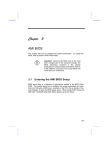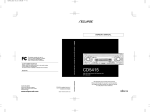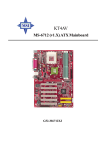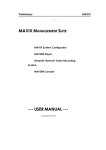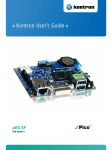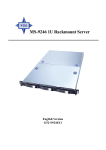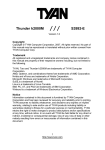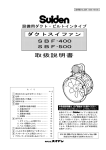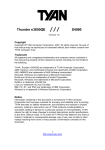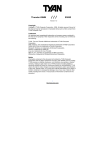Download MSI K1-1000S2 (MS-9245-060) (K11000S2) Server
Transcript
MS-9245 1U Rackmount Server User’s Guide G52-S9245X3 i Manual Rev: 2.1 Release Date: April 2004 FCC-A Radio Frequency Interference Statement This equipment has been tested and found to comply with the limits for a class A digital device, pursuant to part 15 of the FCC rules. These limits are designed to provide reasonable protection against harmful interference when the equipment is operated in a commercial environment. This equipment generates, uses and can radiate radio frequency energy and, if not installed and used in accordance with the instruction manual, may cause harmful interference to radio communications. Operation of this equipment in a residential area is likely to cause harmful interference, in which case the user will be required to correct the interference at his own expense. Notice 1 The changes or modifications not expressly approved by the party responsible for compliance could void the user’s authority to operate the equipment. Notice 2 Shielded interface cables and A.C. power cord, if any, must be used in order to comply with the emission limits. VOIR LA NOTICE D’INSTALLATION AVANT DE RACCORDER AU RESEAU. Micro-Star International MS-9245 This device complies with Part 15 of the FCC Rules. Operation is subject to the following two conditions: (1) this device may not cause harmful interference, and (2) this device must accept any interference received, including interference that may cause undesired operation. ii Copyright Notice The material in this document is the intellectual property of MICRO-STAR INTERNATIONAL. We take every care in the preparation of this document, but no guarantee is given as to the correctness of its contents. Our products are under continual improvement and we reserve the right to make changes without notice. Trademarks All trademarks are the properties of their respective owners. AMD, Opteron™, Athlon™, Athlon™ XP, Thoroughbred™, and Duron™ are registered trademarks of AMD Corporation. Intel® and Pentium® are registered trademarks of Intel Corporation. PS/2 and OS®/2 are registered trademarks of International Business Machines Corporation. Windows® 95/98/2000/2003/NT/XP are registered trademarks of Microsoft Corporation. Netware® is a registered trademark of Novell, Inc. Award® is a registered trademark of Phoenix Technologies Ltd. AMI® is a registered trademark of American Megatrends Inc. Revision History Revision V2.1 Revision History Based on V2.0, adding DDR400, PCI-X 133 Date April 2004 Technical Support If a problem arises with your system and no solution can be obtained from the user’s manual, please contact your place of purchase or local distributor. Alternatively, please try the following help resources for further guidance. Visit the MSI website for FAQ, technical guide, BIOS updates, driver updates, and other information: http://www.msi.com.tw/ Contact our technical staff at: [email protected] iii Safety Instructions 1. 2. 3. 4. 5. Always read the safety instructions carefully. Keep this User’s Manual for future reference. Keep this equipment away from humidity. Lay this equipment on a reliable flat surface before setting it up. The openings on the enclosure are for air convection hence protects the equipment from overheating. DO NOT COVER THE OPENINGS. 6. Make sure the voltage of the power source and adjust properly 110/220V before connecting the equipment to the power inlet. 7. Place the power cord such a way that people can not step on it. Do not place anything over the power cord. 8. Always Unplug the Power Cord before inserting any add-on card or module. 9. All cautions and warnings on the equipment should be noted. 10. Never pour any liquid into the opening that could damage or cause electrical shock. 11. If any of the following situations arises, get the equipment checked by a service personnel: The power cord or plug is damaged. Liquid has penetrated into the equipment. The equipment has been exposed to moisture. The equipment has not work well or you can not get it work according to User’s Manual. The equipment has dropped and damaged. The equipment has obvious sign of breakage. 12. DO NOT LEAVE THIS EQUIPMENT IN AN ENVIRONMENT UNCONDITIONED, STORAGE TEMPERATURE ABOVE 600 C (1400F), IT MAY DAMAGE THE EQUIPMENT. CAUTION: Danger of explosion if battery is incorrectly replaced. Replace only with the same or equivalent type recommended by the manufacturer. 警告使用者: 這是甲類的資訊產品,在居住的環境中使用時,可能會造成無線電干 擾,在這種情況下,使用者會被要求採取某些適當的對策。 iv CONTENTS FCC-A Radio Frequency Interference Statement ................................ ii Copyright Notice ............................................................................... iii Trademarks ........................................................................................ iii Revision History ................................................................................ iii Technical Support .............................................................................. iii Safety Instructions ............................................................................ v Chapter 1. Getting Started ........................................................................ 1-1 System Specifications .......................................................................... 1-2 Mainboard Layout ............................................................................... 1-6 Packing Checklist ................................................................................. 1-7 System Configuration .......................................................................... 1-8 Front View ........................................................................................ 1-9 Rear View ......................................................................................... 1-9 Top View ........................................................................................ 1-14 Chapter 2. Hardware Setup ....................................................................... 2-1 Central Processing Unit: CPU .............................................................. 2-3 CPU Installation Procedures for Socket 940 .................................. 2-3 Memory ................................................................................................ 2-5 DIMM Module Combination ......................................................... 2-5 Installing DDR Modules ................................................................ 2-5 18-Pin Main Power Supply Connector: J10 .................................... 2-6 14-Pin Standby and Status Control Connector: J11 ....................... 2-6 24-Pin SCSI Power and I2C Connector: J12 .................................... 2-6 4-Pin CD-ROM Power Connector: J14 ........................................... 2-6 6-Pin Front Plane USB Connector: J15 ........................................... 2-6 Power Supply ....................................................................................... 2-7 Front Panel Connector: J13 ............................................................ 2-8 SM Card 3rd I2C Bus Connector: JSMB1 ...................................... 2-9 v Connectors ........................................................................................... 2-9 Hard Disk Connectors: IDE1 & IDE2 ............................................. 2-9 Fan Power Connectors: SFAN1/SFAN2/SFAN3/SFAN4/SFAN5 . 2-10 Ultra320 SCSI Connector: SCSI 1 ................................................. 2-11 Server Management Card Connector: J16 .................................... 2-12 Rear Status LED: J20 ................................................................... 2-13 Jumpers .............................................................................................. 2-14 Boot Block Jumper: JBBF1 .......................................................... 2-14 PCI-X 100/133 Jumper: JPCIXB1 .................................................. 2-14 Clear CMOS Jumper: JBAT1 ........................................................ 2-14 Slots ................................................................................................... 2-15 PCI Slots ...................................................................................... 2-15 PCI Interrupt Request Routing .................................................... 2-15 Chapter 3. BIOS Setup .............................................................................. 3-1 Entering Setup ...................................................................................... 3-2 Control Keys ................................................................................. 3-2 Getting Help .................................................................................. 3-3 The Menu Bar ...................................................................................... 3-4 The Main Menu ................................................................................... 3-6 The Advanced Menu ........................................................................... 3-8 Chipset Configuration .................................................................. 3-9 Keyboard Configuration ............................................................. 3-11 I/O Device Configuration ............................................................. 3-12 PCI Configuration ........................................................................ 3-13 Console Redirection .................................................................... 3-15 POST Error Log ........................................................................... 3-16 IPMI ............................................................................................ 3-17 The Security Menu ............................................................................ 3-19 The Power Menu ................................................................................ 3-21 vi The Boot Menu .................................................................................. 3-23 The Exit Menu .................................................................................... 3-24 Chapter 4. Chassis Installation ................................................................ 4-1 System Assembly ................................................................................. 4-2 Chassis Cover ............................................................................... 4-2 CPU and Heatsink .......................................................................... 4-3 CPU and Heatsink (continued) ...................................................... 4-4 DIMM ........................................................................................... 4-5 PCI Cards ....................................................................................... 4-6 IDE Hard Disks .............................................................................. 4-8 Hot Swap SCSI Hard Disks .......................................................... 4-12 Rack Mounting .................................................................................. 4-14 vii Getting Started Chapter 1. Getting Started Getting Started Thanking you for choosing the MS-9245 1U Rackmount Server Barebone! The MS-9245 1U Rackmount Server is a highperformance barebone system powered by AMD OpteronTM processors in Socket 940. With high scalability, reliability, ease of use, and overall value, the MS-9245 makes an ideal choice for value conscious customers. 1-1 MS-9245 1U Rackmount Server System Specifications Mainboard h MSI-9145 mainboard CPU h Supports AMD OpteronTM 200 or OpteronTM 100 up to 2.4GHz Chipset h AMD 8111 I/O bridge h AMD 8131 PCI-X Hub 2D/3D graphics controller h ATI Rage XL Video Controller with 8 MB of memory Memory h Supports up to 8 Registered ECC DDR200/266/333/400 DIMMs h 2GB per DIMM for a maximum memory size of 16 GB PCI Slot h PCI-X 64-bit 100/133MHz x 2 - one full length and one half length PCI slots Drive Bays h 2 Hot-Swap SCSI (or Non-hotswap IDE) HDD h 1 Slim CD-ROM Front I/O h 2 USB ports Rear I/O h 2 USB ports h 1 VGA port h 1 serial port h 2 RJ-45 LAN jacks 1-2 Getting Started SCSI (optional) h Single channel SCSI Ultra320 (LSI 1020) LAN h Broadcom 2 ports Gigabit LAN (BCM5704C) IDE h 2 IDE connectors, supporting up to 4 ATA-100/133 compatible devices MSI Server Management IPMI 1.5 (optional) h MSI-9549 BMC card (with QLogic Zircon UL BMC) and MSI iConsole AP support IPMI 1.5 (optional) FAN h 4 pcs, 40 x 28 mm system fan h 1 pc, 40 x 20mm I/O fan h 3 pcs integrated into power supply Power Supply h 411W max. h Active PFC h Full range 100 ~ 240V AC Dimension (WxDxH) h 440(W) x 660(D) x 43(H) mm Others h High Performance Thermal Solution 1-3 MS-9245 1U Rackmount Server MS-9549 BMC Card Specification BMC Chip : - Qlogic Zircon UL ( ARM7 TDMI 40M RISC) , 128pin PQFP - Host hardware interface : LPC interface - Host software interface : KCS interface Memory Size - 256 X 16 Bits SRAM - 4M Bits Flash Form Factor: - Add-on Card on SO-DIMM (144 pin , Key position in 50) On-board I2Cmux - 9545 On board Connector/Header: - JTAG header (14 pin) for debugging Key Features: - IPMI 1.5 Compliant - Out-of-band LAN based management using RMCP - FRU/SEL access - Remote out-of-band alerts - Event log - Support for CLI (command line interface) over Serial or shared NIC (RMCP) - Ability to update firmware inband unattended - Remote access security (MD5) - Out-of-band environmental monitoring and alerting - Secure remote power control and system reset over Serial or shared NIC (RMCP) - Support Microsoft EMS - Support on-board I2C ADM 1027 to extend Hardware monitor feature System Management: Two SMBus 2.0 (I2C) One SMBus for Broadcom 5704C One SMBus for ADM 1027 , SEEPROM access , CPU thermal sensor 1-4 Getting Started CPU Fan speed control dependent on System Temperature System Fan speed control dependent on System Temperature Sensor Management Monitored Voltage: +12V, +5V, +3.3V, Vcore, 5V standby, +2.5V Thermal protection (CPU/System overheat shut down through BMC) No Chassis Intrusion LED x 6 ( Power , DASD , Fault , ID_LED , BMC Heartbeat ) On-Board Diagnostic LEDs ( 8 x Memory DIMM, 2 x CPU, 5 x FAN ) Support shared NIC (Broadcom 5704C) 1-5 MS-9245 1U Rackmount Server J14 SFAN3 IDE1 J11 J13 SYSFAN1_ERR_LED J15 J12 U2 JBAT1 JBBF1 SFAN1 J10 CPU1_ERR_LED DIMM 8 DIMM 6 DIMM 7 DIMM 3 AMD 8111 IDE2 DIMM 2 DIMM 1 DIMM 5 SCSI 1 LSI 62022A1 U1 BATT + CPU0_ERR_LED J16 PCIX1 AMD 8131 PCIX2 BIOS Broadcom 5704C ATi RAGE XL J20 LAN1 LAN2 USB port USB port JVGA1 COM1 JSMB1 COM2 MS-9145 v1.X Mainboard 1-6 SW1 SFAN4 SYSFAN5_ERR_LED SYSFAN3_ERR_LED SYSFAN2_ERR_LED SFAN2 SYSFAN4_ERR_LED Mainboard Layout SFAN5 Getting Started Packing Checklist Unpack the package and check if all items listed below are present. If any item contained in the package is damaged or missing, please contact your local dealer for replacement. In addition, keep the box and packing materials for possible future use. Your MS-9245 1U Rackmount Server Barebone package should contain the following items: * MS-9245 1U Rackmount Server x1 (including a MS-9145 mainboard, a MS-9549 BMC card, a Power Supply and a Fan Duct) * Heatsink x2 * 6”32 x 5 screw x8 * HDD tray set (2 in a set, IDE model) x2 * Rail Kit x1 (including two rails and cable ties) * User’s Guide x1 * Installation Floppy Disk x1 * Server Driver CD x1 * iConsole Suite CD (optional) x1 1-7 MS-9245 1U Rackmount Server System Configuration This section shows the configuration of the MS-9245 from different angles, and the connectors and buttons on the front and back panel. Front View 1 4 1. 2. 3. 4. 5. 6. 7. 8. 9. 1-8 9 3 2 5 6 7 8 Slim CD-ROM (optional) Hot Swap 80-pin SCSI HDD: HDD 1 (ID0) IDE HDD: HDD 2 (Primary Slave) Hot Swap 80-pin SCSI HDD: HDD 2 (ID1) IDE HDD: HDD 1 (Primary Master) USB Port 1 USB Port 2 (from left to right) IDE HDD Activity LED, Location LED, Info LED & Error LED** Reset Button Power Button Power LED* Getting Started Rear View 3 10 2 4 1 1. 2. 3. 4. 5. 6. 7. 8. 9. 10. 5 6 9 7 8 AC Power Connector Half Length PCI Slot 2 Full Length PCI Slot 1 Serial Port VGA Port (from left to right) USB Port 3 & USB Port 4 (from left to right) Gbit Port 2 & Gbit Port 1 Power LED* NMI Switch Error LED** NOTE * Please refer to Table 1. MS-9245 Front Bezel & Rear I/O LEDs Definitions for more information on Power LED. ** Please refer to Table 2. MS-9245 System Error and Diagnostic LEDs Definitions for more information on Error LED. 1-9 MS-9245 1U Rackmount Server Table 1. MS-9245 Front Bezel & Rear I/O LEDs Definitions LED Power Color Green State Description ON System operating Blink System main power off and standby power on IDE HDD Activity Error Location OFF OFF AC power removed Green Random blink IDE HDD access activity OFF OFF No disk activity Amber ON Some component error/failure OFF OFF System normal operation Blue ON Identify active via iConsole (Controlled by MSI command iConsole AP only) OFF Information Amber OFF No identification Reserved for new BIOS function upgrade Swappable SCSI Green Random blink HDD access activity HDD Access OFF OFF No disk activity 1-10 Getting Started Table 2. MS-9245 System Error and Diagnostic LEDs Definitions Item Error LED Diagnostic LED Description/Symptoms 1 OFF OFF Normal operation 2 ON CPU Error LED ON Processor related problems 3 ON SCSI Error LED ON SCSI hard drive Error/failure 4 ON FAN Error LED ON Fan failure 5 ON Memory Error LED ON Memory error/failure 6 ON N/A Power supply error/failure Diagnostic LEDs Diagnostic LEDs use signal display to help users understand their system.When POST or Service Processor detects an error, the corresponding LEDs light up to alert the user to the condition and help service personnel identify the failing component. A system error single LED on the front panel and in the rear of the system first alters the users that an error has occurred. Service personnel next check inside the system to determine which subsystem has an error LED lit. This information helps the service personnel to locate the failing component for replacement. The full failing path remians lit until POST no longer exists or the error is fixed. 1-11 MS-9245 1U Rackmount Server The Rear Panel provides the following connectors: LAN (RJ-45) Jacks: Giga-bit LAN The mainboard provides two standard RJ-45 jacks for connection to Local Area Network (LAN). Giga-bit LAN enables data to be transferred at 1000, 100 or 10Mbps. You can connect a network cable to either LAN jack. Giga-bit LAN Pin Definition PIN SIGNAL DESCRIPTION 1 D0P Differential Pair 0+ 2 D0N Differential Pair 0- 3 D1P Differential Pair 1+ 4 D2P Differential Pair 2+ 5 D2N Differential Pair 2- 6 D1N Differential Pair 1- 7 D3P Differential Pair 3+ 8 D3N Differential Pair 3- USB Connectors The mainboard provides an UHCI (Universal Host Controller Interface) Universal Serial Bus root for attaching USB devices such as keyboard, mouse or other USB-compatible devices. You can plug the USB device directly into ths connector. USB Port Description 1 2 3 4 USB Port 1-12 PIN SIGNAL DESCRIPTION 1 2 3 4 VCC -Data 0 +Data0 GND +5V Negative Data Channel 0 Positive Data Channel 0 Ground Getting Started Serial Port Connectors: COM 1 & COM 2 (optional) The mainboard offers two 9-pin DIN connectors for serial ports COM 1 and COM 2. The ports are 16550A high speed communication ports that send/ receive 16 bytes FIFOs. You can attach a serial mouse or other serial devices directly to them. COM 1 Pin Definition PIN 1 2 3 4 5 6 7 8 9 1 2 3 4 5 6 7 8 9 COM 1 SIGNAL DCD SIN SOUT DTR GND DSR RTS CTS RI DESCRIPTION Data Carry Detect Serial In or Receive Data Serial Out or Transmit Data Data Terminal Ready) Ground Data Set Ready Request To Send Clear To Send Ring Indicate COM 2 Pin Definition 97531 8642 COM 2 PIN DESCRIPTION PIN DESCRIPTION 1 3 5 7 9 Data Carrier Detect Transmit Data Ground Request to Send Ring Indicator 2 4 6 8 10 Receive Data Data Terminal Ready Data Set Ready Clear to Send Ground VGA Connector The mainboard provides a DB 15-pin female connector to connect a VGA monitor. 5 1 15 11 VGA Connector (DB 15-pin) Pin 1 2 3 4 5 6 7 8 9 10 11 12 13 14 15 Signal Description RED GREEN BLUE N/C GND GND GND GND +5V GND N/C SDA Horizontal Sync Vertical Sync SCL 1-13 MS-9245 1U Rackmount Server Top View 2 5 6 1 3 3 4 4 7 1. 2. 3. 4. 5. 6. 7. 1-14 Proprietary Power Supply Slim CD-ROM Drive DIMM Slots PCI Slots Heatsinks Fan Duct AC Power Connector 5 Hardware Setup Chapter 2. Hardware Setup Hardware Setup This chapter tells you how to install the CPU, memory modules, and expansion cards, as well as how to setup the jumpers on the mainboard. Also, it provides the instructions on connecting the peripheral devices, such as the mouse, keyboard, etc. While doing the installation, be careful in holding the components and follow the installation procedures. 2-1 MS-9245 1U Rackmount Server Central Processing Unit: CPU The mainboard supports Single AMD® Opteron UP or Dual AMD® Opteron DP™ processor(s). The mainboard uses two CPU sockets called Socket 940 for easy CPU installation. You can install SINGLE or DUAL CPUs on the mainboard to meet your own needs. Keep the following points in mind before installing CPU(s): 1. If SINGLE CPU is intended, always install the CPU on the U1 socket. U1 2. To install DUAL CPUs on the board, you must use the same type/ stepping of AMD Opteron DP™ CPUs running at the same frequency. WARNING! Thermal Issue for CPU As processor technology pushes to faster speeds and higher performance, thermal management becomes increasingly crucial when building computer systems. Maintaining the proper thermal environment is key to reliable operation. As such, the processor must be maintained in the specified thermal requirements. You need to add thermal grease between the CPU and heatsink to improve heat dissipation. Then, make sure that the CPU and heatsink are securely fastened and in good contact with each other. These are needed to prevent damaging the processor and ensuring reliable operation. If you want to get more information on the proper cooling, you can visit AMD’s website for reference. 2-2 Hardware Setup CPU Installation Procedures for Socket 940 Open Lever 1. Make sure that the computer is turned off, and the power cord disconnected before installing the CPU. Slid P ing l at e 2. Pull the lever sideways away from the socket, and raise it up to a 90-degree angle. 3. Locate the cut edge of the CPU. When the CPU is installed into the socket, this cut edge should be aligned with the corner marking an arrow on the Socket 940. Cut edge Please note that the CPU can only fit in a correct orientation, DO NOT use force to install the CPU into the socket. Corner marking an arrow 4. Place the CPU onto the socket and press it down firmly into the socket. The pins of the CPU should be embedded into the socket completely. 5. Close the lever to secure the CPU. Do not close the level until the CPU’s pins are fully inserted; otherwise, the pins may be damaged. Press down the CPU O Close Lever X 2-3 MS-9245 1U Rackmount Server Memory The mainboard supports up to eight registered ECC DDR200/266/333 DIMMs providing up to 16GB of memory. Each DIMM slot supports up to a maximum size of 2GB. You can install either single- or double-sided modules to meet your own needs. DDR DIMM Slots DIMM Module Combination You can install either one or two DIMM modules on the slots. Use Slot 1, 3, 6 or 8 for single DDR module installation. If DDR modules are installed on Slot 5 ~ 8, CPU2 must be installed. Memory modules can be installed in any combination as follows: Option Memory Modules Installed 1 Slot 1&2, Slot 3&4, Slot 5&6, Slot 7&8 2 Slot 1&2&3&4, Slot 1&2&5&6, Slot 1&2&7&8, Slot 3&4&5&6, Slot 3&4&7&8, Slot 5&6&7&8 3 Slot 1&2&3&4&5&6, Slot 1&2&3&4&7&8, Slot 1&2&5&6&7&8, Slot 3&4&5&6&7&8 4 Slot 1&2&3&4&5&6&7&8 NOTE Memory modules “in pairs” must be of the same type and size. 2-4 Hardware Setup Installing DDR Modules 1. The DDR DIMM has only one notch on the center of module. The module will only fit in the right orientation. 2. Insert the DIMM memory module vertically into the DIMM slot. Then push it in until the golden finger on the memory module is deeply inserted in the socket. 3. The plastic clip at each side of the DIMM slot will automatically close. Volt Notch NOTE You can barely see the golden finger if the module is properly inserted in the socket. 2-5 MS-9245 1U Rackmount Server Power Supply The mainboard supports SSI power supply for the power system. Before inserting the power supply connector, always make sure that all components are installed properly to ensure that no damage will be caused. 18-Pin Main Power Supply Connector: J10 This connector provides power supply to the system board. 14-Pin Standby and Status Control Connector: J11 This connector provides power supply to the system board. 24-Pin SCSI Power and I2C Connector: J12 This connector is an optional power connector to provide power output to the SCSI HDD. 4-Pin CD-ROM Power Connector: J14 This connector provides power supply to the CD-ROM Drive. 6-Pin Front Plane USB Connector: J15 This connector provides power supply to the front USB ports. 18 9 12 7 14 1 4 24 J11 1 10 J10 2-6 1 13 J12 3 6 1 4 J15 4 2 3 1 J14 Hardware Setup J12 J10 5 6 7 8 9 10 11 12 13 14 12V_1 12V_2 12V_3 12V_4 RET1 RET2 RET3 RET4 RET5 RET6 RET7 RET8 RET9 RET10 5V_1 5V_2 5V_3 5V_4 MH1 MH2 1 2 3 4 17 18 19 21 23 24 15 16 17 18 9 MH1 MH2 Molex_44472-1853 2 4 6 8 12 14 16 22 12V_1 12V_2 12V_3 12V_4 I2C_A0 I2C_A1 I2C_A2 I2C_CLK I2C_DATA I2C_INT 5V_1 5V_2 5V_3 PRES_DET# RESET GND1 GND2 GND3 GND4 GND5 GND6 GND7 GND8 3P4V/NC MH1 MH2 1 3 5 7 11 13 15 10 20 MH1 MH2 Molex_43045-2413 J11 OC 1 2 3 4 7 +5VSB +5VSB2 -ON_+OFF -EPOW +5VSB_RET +5VSB_RET2 -FAN_FAULT SDA SCL DCGOOD/-POR -FAN_HS SPARE1 SPARE2 Molex_43045-1413 MH1 MH2 8 5 6 11 12 9 10 J14 1 4 12V GND1 5V GND2 MH1 MH2 2 3 MH1 MH2 Molex_43045-0414 13 14 MH1 MH2 J15 1 2 3 4 5 6 C1 C2 C3 C4 C5 C6 CON2X3 2-7 MS-9245 1U Rackmount Server Connectors SM Card 3rd I2C Bus Connector: JSMB1 The mainboard provides one I2C (also known as I2C) Bus connector for users to connect to System Management Bus (SMBus) interface. 1 JSMB1 Pin Definition 3 JSMB1 PIN SIGNAL 1 2 3 DATA CLK ALT# Front Panel Connector: J13 The mainboard provides one front panel connector for electrical connection to the front panel switches and LEDs. 26 25 2 1 J13 J13 Pin Definition 2-8 Pin Description Pin Description 1 GND 2 SM_PWRLED# 3 5 7 9 11 13 15 17 19 21 23 25 GND GND +5VSB +5VSB +5VSB Unused +5V +5V +5V +5V GND GND 4 6 8 10 12 14 16 18 20 22 24 26 FP2SW_RST# Unused Unused SMB_2_DATA SMB_2_CLK GND SM_FP_DET# USB1_OC_L SB_GPIO14 SM_LED4_SEL FP2SW_PWRBTN# Unused Hardware Setup Hard Disk Connectors: IDE1 & IDE2 The mainboard has a 32-bit Enhanced PCI IDE and Ultra DMA 33/66/100/ 133 controller that provides PIO mode 0~4, Bus Master, and Ultra DMA 33/66/ 100/133 function. You can connect up to four hard disk drives, CD-ROM, 120MB Floppy (reserved for future BIOS) and other devices. IDE2 IDE1 IDE1 (Primary IDE Connector) The first hard drive should always be connected to IDE1. IDE1 can connect a Master and a Slave drive. You must configure second hard drive to Slave mode by setting the jumper accordingly. IDE2 (Secondary IDE Connector) IDE2 can also connect a Master and a Slave drive. NOTE If you install two hard disks on cable, you must configure the second drive to Slave mode by setting its jumper. Refer to the hard disk documentation supplied by hard disk vendors for jumper setting instructions. 2-9 MS-9245 1U Rackmount Server Fan Power Connectors: SFAN1/SFAN2/SFAN3/SFAN4/SFAN5 The SFAN1/SFAN2/SFAN3/SFAN4/SFAN5 (system fans) support system cooling fan with +12V. It supports three-pin head connector. When connecting the wire to the connectors, always take note that the red wire is the positive and should be connected to the +12V, the black wire is Ground and should be connected to GND. If the mainboard has a System Hardware Monitor chipset on-board, you must use a specially designed fan with speed sensor to take advantage of the CPU fan control. +12V GND +12V Sensor SFAN1 Sensor GND SFAN2 Sensor +12V GND SFAN3 Sensor +12V GND SFAN5 Sensor +12V GND SFAN4 NOTE 1. Always consult the vendors for proper CPU cooling fan. 2. SFAN supports the fan control. MS-9245 will automatically control the CPU fan speed according to the system temperature. 2-10 Hardware Setup Ultra320 SCSI Connector: SCSI 1 SCSI (Small Computer System Interface) is a hardware interface that allows for connection of up to 15 peripheral devices. The mainboard provides one SCSI channel (SCSI 1) for you to connect SCSI devices such as SCSI hard disks. 68-Pin Ultra320 SCSI Connector 35 1 68 34 SCSI 1 Pin Description Pin Description 1 2 +DB(12) +DB(13) 35 36 -DB(12) -DB(13) 3 4 5 6 7 8 9 10 11 12 13 14 15 16 17 18 19 20 21 22 23 24 25 26 27 28 29 30 31 32 33 34 +DB(14) +DB(15) +DB(P1) +DB(0) +DB(1) +DB(2) +DB(3) +DB(4) +DB(5) +DB(6) +DB(7) +DB(P) GROUND DIFFSENS TERMPWR TERMPWR RESERVED GROUND +ATN GROUND +BSY +ACK +RST +MSG +SEL +C/D +REQ +I/O +DB(8) +DB(9) +DB(10) +DB(11) 37 38 39 40 41 42 43 44 45 46 47 48 49 50 51 52 53 54 55 56 57 58 59 60 61 62 63 64 65 66 67 68 -DB(14) -DB(15) -DB(P1) -DB(0) -DB(1) -DB(2) -DB(3) -DB(4) -DB(5) -DB(6) -DB(7) -DB(P) GROUND GROUND TERMPWR TERMPWR RESERVED GROUND -ATN GROUND -BSY -ACK -RST -MST -SEL -C/D -REQ -I/O -DB(8) -DB(9) -DB(10) -DB(11) 2-11 MS-9245 1U Rackmount Server Server Management Card Connector: J16 This connector allows you to insert a Server Management Card. J16 143 1 144 2 J16 1 3 5 7 9 11 13 15 17 19 21 23 25 27 29 31 33 35 37 39 41 43 45 47 49 51 53 55 57 59 61 63 65 67 69 71 73 75 77 79 81 83 85 87 89 91 93 95 97 99 101 103 105 107 109 111 113 115 117 119 121 123 125 127 129 131 133 135 137 139 141 143 COM1_DI(I) LPC_AD0 COM1_RST#(O) LPC_AD1 COM1_DCD#(I) LPC_AD2 COM1_RI#(I) LPC_AD3 COM1_CTS#(I) GND COM1_DO(O) (I)LPC_CLK COM1_DTR#(O) LPC_RST# COM1_DSR#(I) LPC_FRAME# COM1_EN/SW#(O) GND COM2_EN/SW#(O) (O)LPC_INT# COM_BUS_EXCH(O) (O)LPC_DRQ# POST/I2C_ACK#(O) (I)POST/I2C_REQ# 5VSB_VDD_ANALOG 5VSB FAN_TACH0(I) (O)FAN_PWM0 FAN_TACH1(I) (O)FAN_PWM1 FAN_TACH2(I) (O)FAN_PWM2 FAN_TACH3(I) (O)FAN_PWM3 FAN_TACH4(I) (O)FAN_PWM4 FAN_TACH5(I) (O)FAN_PWM5 NC NC NC NC NC (I)GP_INT1# NC (I)GP_INT2# NC (I)GP_INT3# NC (I)GP_INT4# GND_ANALOG GND I2C_0_SDA I2C_1_SDA I2C_0_SCL I2C_1_SCL I2C_0_INT# (I)I2C_1_INT# 3VSB_ANALOG 3.3VSB I2C_2_SDA I2C_3_SDA I2C_2_SCL I2C_3_SCL I2C_INT#(I) (I)I2C_3_INT# SB_PWR_PG(I) EPOW# Main_PWR_PG(I) (I)SYS_RST# ANALOG_VOLT0(I) (O)SYS_RST_OUT ANALOG_VOLT1(I) (O)SYS_PWRON_OUT ANALOG_VOLT2(I) (I)SYS_PWRON_IN ANALOG_VOLT3(I) (O)BMC_WD# ANALOG_VOLT4(I) (I)FEA_DET0 ANALOG_VOLT5(I) (I)FEA_DET1 ANALOG_VOLT6(I) (O)I2C_0_RST# ANALOG_VOLT7(I)_BAT (O)I2C_2_RST# RTS_SEN_EN(O) (O)I2C_2_MUX_DIS# 3.3VSB_ANALOG 3.3VSB NC NC INSERT_DET(I) LED0 BMC_VER0(O) LED1 BMC_VER1(O) LED2 PLAN_LVL0(I) LED3 PLAN_LVL1(I) LED4 PLAN_LVL2(I) LED5 PLAN_LVL3(I) LED6 SYS_ID0(I) LED7 SYS_ID1(I) NC SYS_ID2(I) NC SYS_ID3(I) NC SYS_ID4(I) NC NC NC NC NC GND GND 485+ NC 485NC GND GND PWR_BTN_IN(I) NC PWR_BTN_OUT(O) NC BMC_Heartbeat(O) (I)SYS_RTC BMC_SMI# (I)REM_BTN_IN SYS_NMI#(I) (I)HD_ACT# COM_EXCH_DIS(O) (I)I2C_DIS_ALL COM_SHUT(O) (I)I2C_MEM_SW 5VSB 5VSB SODIMM144__8MMP 2-12 2 4 6 8 10 12 14 16 18 20 22 24 26 28 30 32 34 36 38 40 42 44 46 48 50 52 54 56 58 60 62 64 66 68 70 72 74 76 78 80 82 84 86 88 90 92 94 96 98 100 102 104 106 108 110 112 114 116 118 120 122 124 126 128 130 132 134 136 138 140 142 144 Hardware Setup Rear Status LED: J20 The LED shows the error and power status. Error LED (Amber) Power LED (Green) 2-13 MS-9245 1U Rackmount Server Jumpers Boot Block Jumper: JBBF1 Users can short connect pin#2-3 to recover the system BIOS with a Recovery Floppy. When the system is done with the job, the buzzer will beep to notify the user and set the jumper to its normal state (pin#1-2 short connected). 1 3 JBBF1 1 3 1 Recovery Normal PCI-X 100/133 Jumper: JPCIXB1 The jumper is used to set the channel B of 64-bit PCI bus (PCIX) to run at 100MHz or at 133MHz (for use with one PCI-X 133 device). 1 3 JPCIXB1 1 3 100MHz 1 133MHz Clear CMOS Jumper: JBAT1 If you want to clear the system configuration, use the JBAT1 (Clear CMOS Jumper ) to clear data. 1 JBAT1 3 1 Keep Data 3 1 Clear Data NOTE You can clear CMOS by shorting 2-3 pin while the system is off. Then return to 1-2 pin position. Avoid clearing the CMOS while the system is on; it will damage the mainboard. 2-14 Hardware Setup Slots The motherboard provides two 64-bit PCI-X 100/133MHz slots. One is full length and the other is half length. PCI Slots Two PCI slots allow you to insert the expansion cards to meet your needs. When adding or removing expansion cards, make sure that you unplug the power supply first. Meanwhile, read the documentation for the expansion card to make any necessary hardware or software settings for the expansion card, such as jumpers, switches or BIOS configuration. PCI Interrupt Request Routing The IRQ, acronym of interrupt request line and pronounced I-R-Q, are hardware lines over which devices can send interrupt signals to the microprocessor. The PCI IRQ pins are typically connected to the PCI bus INT A# ~ INT D# pins as follows: IRQ Routing Devices Order 1 Order 2 Order 3 Order 4 PCI Slot 1 INT A# INT B# INT C# INT D# PCI Slot 2 INT D# INT A# INT B# INT C# LAN INT A# INT B# VGA INT A# SCSI INT C# Primary IDE Interrupt: IRQ14 (for AMD8111) Secondary IDE Interrupt: IRQ15 (for AMD8111) 2-15 BIOS Setup Chapter 3. BIOS Setup BIOS Setup This chapter provides information on the BIOS Setup program and allows you to configure the system for optimum use. You may need to run the Setup program when: An error message appears on the screen during the system booting up, and requests you to run SETUP. You want to change the default settings for customized features. Upon boot-up, the 1st line appearing after the memory count is the BIOS version. It is usually in the format: A6380MS V1.0 091096 where: 1st digit refers to the BIOS maker as A = AMI, W = AWARD, and P = PHOENIX. 2nd - 5th digit refers to the model number. 6th - 7th digit refers to the customer as MS = all standard customers. V1.0 refers to the BIOS version. 091096 refers to the date this BIOS was released. 3-1 MS-9245 1U Rackmount Server Entering Setup Power on the computer and the system will start POST (Power On Self Test) process. When the message below appears on the screen, press <F2> key to enter Setup. Press F2 to enter SETUP If the message disappears before you respond and you still wish to enter Setup, restart the system by turning it OFF and On or pressing the RESET button. You may also restart the system by simultaneously pressing <Ctrl>, <Alt>, and <Delete> keys. Control Keys Key <F1> or <Alt-H> <Esc> ↔ arrow keys ↑ or ↓ arrow keys <Tab> or <Shift-Tab> <Home> or <End> <PgUp> or <PgDn> <F5> or <-> <F6> or <+> or <Space> <F9> <F10> <Enter> 3-2 Function General Help window Exit this menu Select a different menu Move cursor up and down Cycle cursor up and down Move cursor to top or bottom of window Move cursor to next or previous page Select the Previous Value for the field Select the Next Value for the field Load the Default Configuration values for this menu Save and exit Execute Command or Enter Submenu BIOS Setup Getting Help After entering the Setup menu, the first menu you will see is the Main Menu. Main Menu The main menu lists the setup functions you can make changes to. You can use the arrow keys ( ↑↓ ) to select the item. The on-line description of the highlighted setup function is displayed at the bottom of the screen. Sub-Menu If you find a right pointer symbol (as shown in the right view) appears to the left of certain fields that means a sub-menu can be launched from this field. A sub-menu contains additional options for a field parameter. You can use arrow keys ( ↑↓ ) to highlight the field and press <Enter> to call up the sub-menu. Then you can use the control keys to enter values and move from field to field within a sub-menu. If you want to return to the main menu, just press the <Esc >. 8 IDE Primary Master 8IDE Primary Slave 8IDE Secondary Master 8IDE Secondary Slave General Help <F1> The BIOS setup program provides a General Help screen. You can call up this screen from any menu by simply pressing <F1>. The Help screen lists the appropriate keys to use and the possible selections for the highlighted item. Press <Esc> to exit the Help screen. MSI Reminds You... The items under each BIOS category described in this chapter are under continuous update for better system performance. Therefore, the description may be slightly different from the latest BIOS and should be held for reference only. 3-3 MS-9245 1U Rackmount Server The Menu Bar Once you enter PhoenixBIOS Setup Utility, the Main Menu will appear on the screen. On the Main Menu screen, you will see basic BIOS settings including system time & date, and the setup categories the BIOS supplies. Use Arrow keys to move among the items and menus, and make changes to the settings. PhoenixBIOS Setup Utility Main Advanced Security Power Boot Exit Item Specific Help System Time System Date [09:10:11] [05/25/2003] 8IDE Primary Master 8IDE Primary Slave 8IDE Secondary Master 8IDE Secondary Slave Large Disk Access Mode : [None] [None] [CD-ROM] [None] [DOS] Boot Summary Screen : [Disabled] System Memory : Extended Memory : 624KB 510MB F1 Help Esc Exit ↑↓ Select Item ↔ Select Menu -/+ Change Values Select 8 Sub-Menu <Tab>, <Shift+Tab>, or <Enter> selects field. F9 Setup Defaults F10 Save and Exit Main Menu Use this menu for basic system configurations, such as time, date etc. AdvancedMenu Use this menu to set up the items of special enhanced features available on your system’s chipset. Security Menu Use this menu to set Supervisor and User Passwords and the Backup and Virus-Check reminders. 3-4 BIOS Setup Power Menu Use this menu to specify your settings for power management. Boot Menu Use this menu to specify the priority of boot devices. Exit Menu This menu allows you to load the BIOS default values or factory default settings into the BIOS and exit the BIOS setup utility with or without changes. 3-5 MS-9245 1U Rackmount Server The Main Menu The items inside the Main menu are for basic system information and configuration. Each item includes none, one or more setup items. Use the Up/ Down arrow keys or <Tab> to highlight the item or field you want to modify and use the <+> or <-> key to switch to the value you prefer. PhoenixBIOS Setup Utility Main Advanced Security Power Boot Exit Item Specific Help System Time System Date [09:10:11] [05/25/2003] 8IDE Primary Master 8IDE Primary Slave 8IDE Secondary Master 8IDE Secondary Slave Large Disk Access Mode : [None] [None] [CD-ROM] [None] [DOS] Boot Summary Screen : [Disabled] System Memory : Extended Memory : 624KB 510MB F1 Help Esc Exit ↑↓ Select Item ↔ Select Menu -/+ Change Values Select 8 Sub-Menu <Tab>, <Shift+Tab>, or <Enter> selects field. F9 Setup Defaults F10 Save and Exit System Time The time format is <HH> <MM> <SS>. System Date The date format is <MM> <DD> <YYYY>. Primary/Secondary Master/Slave Press PgUp/<+> or PgDn/<-> to select [Manual], [None] or [Auto] type. Note that the specifications of your drive must match with the drive table. The hard disk will not work properly if you enter improper information for this category. If your hard disk drive type is not matched or listed, you can use [Manual] to define your own drive type manually. 3-6 BIOS Setup If you select [Manual], related information is asked to be entered to the following items. Enter the information directly from the keyboard. This information should be provided in the documentation from your hard disk vendor or the system manufacturer. Type Multi-Sector Transfers LBA Mode Control 32-Bit I/O Tranfer Mode Ultra DMA Mode Select how to define the HDD parameters Any selection except Disabled determines the number of sectors transferred per block Enabling LBA causes Logical Block Ad dressing to be used in place of Cylinders, Heads and Sectors. Enables 32-bit communication between CPU and IDE card Selects the method for transferring the data between the hard disk and system memory Indicates the type of Ultra DMA. Large Disk Access Mode Select DOS if you have DOS. Select Other if you have another operating system such as UNIX. A large disk is one that has more than 1024 cylinders, more than 16 heads, or more than 63 tracks per sector. Options: [DOS], [Other]. Boot Summary Screen Selecting Enabled displays system summary screen during boot up. Options: [Enabled], [Disabled]. System Memory It displays amount of conventional memory detected during boot up. ExtendedMemory It displays the amount of extended memory detected during boot up. 3-7 MS-9245 1U Rackmount Server The Advanced Menu Items in the menu are divided into 7 sub-menus. Each sub-menu provides more settings. To enter the sub-menu, highligh the sub-menu you want to configure and press <Enter>. PhoenixBIOS Setup Utility Main Advanced Security Power Boot Exit Item Specific Help Installed O/S : Reset Configuration Data : Multiprocessor Specification : QuickBoot Mode : [Other] [No] [1.4] [Enabled] 8Chipset Configuration 8Keyboard Configuration 8I/O Device Configuration 8PCI Configuration 8Console Redirection 8POST Error Log 8IPMI F1 Help Esc Exit ↑↓ Select Item ↔ Select Menu Select the operating system installed on your system which you will use most commonly. Note: An incorrect setting can cause some operating systems to display unexpected behavior. -/+ Change Values Select 8 Sub-Menu F9 Setup Defaults F10 Save and Exit Install O/S Select the operating system installed on your system which you will use most commonly. Options: [Other], [Win95], [Win98], [WinMe], [Win2000]. Reset Configuration Data Select Yes if you want to clear the Extended System configuration Data (ESCD) area. Options: [Yes], [No]. Multiprocessor Specification This item allows you to configure the MP Specification revision level. Some operating systems will require 1.1 for compatibility reason. Options: [1.4], [1.1]. 3-8 BIOS Setup Quick Boot Mode This feature allows the system skip certain tests while booting. This will decrease the time needed to boot the system. Options: [Enabled], [Disabled]. Chipset Configuration The sub-menu is used to configure chipset features for optimal system performance. PhoenixBIOS Setup Utility Advanced Item Specific Help Chipset Configuration Setup Warning Setting items on this menu to incorrect values may cause your system to malfunction. Dram Bank Interleave : Node Memory Interleave : HPET Timer HT Link Frequence : ECC : Dram ECC : ECC Scrub Redirection : Chip-Kill: [AUTO] [Disabled] [Enabled] [800MHz] [Enabled] [Enabled] [Disabled] [Enabled] DCACHE ECC Scrub CTL L2 ECC Scrub CTL Dram ECC Scrub CTL [Disabled] [Disabled] [Disabled] F1 Help Esc Exit ↑↓ Select Item ↔ Select Menu -/+ Change Values Select 8 Sub-Menu Interleave memory blocks across dram chip selects. BIOS will AUTO detect capability on each Node. F9 Setup Defaults F10 Save and Exit Dram Bank Interleave Interleave memory blocks across dram chip selects. Options: [Auto], [Disabled]. Node Memory Interleave Interleave memory blocks across Processor Nodes. BIOS will AUTO detect the capability of Memory System. Options: [Disabled], [AUTO]. 3-9 MS-9245 1U Rackmount Server HPETTimer This item allows you to enable/disable HPET high precision event timer. Setting to Disabled will turn off the device and remove it from the ACPI namespace. Options: [Enabled], [Disabled]. HT Link Frequency This setting specifies the HT (HyperTransport) frequency between CPU0 & CPU1. Setting options: [800MHz], [1GHz]. ECC This is a global enable function for all blocks within CPU core and North Bridge. After loading setup defaults, restart and enter setup to access Dram ECC setup options. Options: [Enabled], [Disabled]. DramECC If all memory in the system supports ECC, enabling this will initial scrub dram and enable system requests to dram to be checked and/or corrected. Options: [Enabled], [Disabled]. ECC Scrub Redirection Enable Scrubber to correct errors detected in Dram during normal CPU requests (Foreground scrubbing). Options: [Enabled], [Disabled]. Chip-Kill This item allows you to enable/disable Chip-Kill ECC on Nodes with all x4 ECC capable dimms. Options: [Enabled], [Disabled]. DCACHE ECC Scrub CTL This feature sets the rate of background scrubbing for DCACHE lines. Options: [Disabled], [40 ns], [80 ns], [160 ns], [320 ns], [640 ns], [1.28 us], [2.56 us]. L2 ECC Scrub CTL This feature sets the rate of background scrubbing for L2 cache lines. Options: [Disabled], [40 ns], [80 ns], [160 ns], [320 ns], [640 ns], [1.28 us], [2.56 us]. 3-10 BIOS Setup Dram ECC Scrub CTL This feature sets the rate of BACKGROUND scrubbing for Dram. (In addition to normal ECC scrubbing from system requests.) Options: [Disabled], [1.31 ms], [2.62 ms], [5.24 ms], [10.49 ms], [20.97 ms], [42.0 ms], [84.0 ms]. Note: BACKGROUND agent works independently of CPU requests and bus masters, but cannot be enabled without first enabling Dram ECC. Keyboard Configuration The sub-menu is used to configure keyboard features for optimal system performance. PhoenixBIOS Setup Utility Advanced Item Specific Help Keyboard Configuration NumLock : Keyboard auto-repeat rate : Keyboard auto-repeat dealy : F1 Help Esc Exit ↑↓ Select Item ↔ Select Menu [On] [30/sec] [1/4 sec] -/+ Change Values Select 8 Sub-Menu Selects Power-on State for NumLock. F9 Setup Defaults F10 Save and Exit NumLock On or Off turns NumLock on or off at boot up. auto turns NumLock on if it finds a numeric key pad. Options: [On], [Off]. Keyboard auto-repeat rate It sets the number of times a second to repeat a keystroke when you hold the key down. Options: [30/sec], [26.7/sec], [21.8/sec], [18.5/sec], [13.3/ sec], [10/sec], [6/sec], [2/sec]. 3-11 MS-9245 1U Rackmount Server Keyboard auto-repeat delay It sets the delay time after the key is held down before it begins to repeat the keystroke. Options: [1/4 sec], [1/2 sec], [3/4 sec], [1 sec]. I/O Device Configuration The sub-menu is used to configure I/O Devices for optimal system performance. PhoenixBIOS Setup Utility Advanced Item Specific Help I/O Device Configuration Serial port A : Base I/O address : Interrupt : Serial port B : Base I/O address : Interrupt : [Enabled] [3F8] [IRQ 4] [Enabled] [2F8] [IRQ 3] Configure serial port A using options: [Disabled] No configuration [Enabled] User configuration [Auto] BIOS or OS chooses configuration (OS Controlled) Displayed when controlled by OS F1 Help Esc Exit ↑↓ Select Item ↔ Select Menu -/+ Change Values Select 8 Sub-Menu F9 Setup Defaults F10 Save and Exit Serial port A/B Setting to [Enabled] allows users to configure the base I/O address and IRQ of Port A/Port B manually. Selecting Auto allows BIOS to automatically determine the correct base I/O port address. Options: [Enabled], [Disabled], [Auto]. Base I/O address It specifies the base I/O address for Port A/Port B. Options: [3F8], [2F8], [3E8], [2E8]. Interrupt It specifies the interrupt for Port A/Port B. Options: [IRQ 3], [IRQ 4]. 3-12 BIOS Setup PCI Configuration Press PgUp/<+> or PgDn/<-> to PCI Configuration. The following submenu will appear. PhoenixBIOS Setup Utility Advanced Item Specific Help PCI Configuration Setup items for configuring the specific PCI device 8PCI Device, Slot #1 8PCI Device, Slot #2 8Onboard SCSI Device 8Onboard LAN Device F1 Help Esc Exit ↑↓ Select Item ↔ Select Menu -/+ Change Values Select 8 Sub-Menu F9 Setup Defaults F10 Save and Exit PCI Device, Slot #1 & PCI Device, Slot #2 The sub-menu is used to configure the specific PCI device. Press PgUp/ <+> or PgDn/<-> to PCI Device, Slot#1 or 2. The following submenu will appear. Option ROM Scan Use this feature to initialize device expansion ROM. Enable Master Use this feature to enable selected device as a PCI bus master. Latency Timer Use this feature to minimize guaranteed time slice allotted for bus master in units of PCI bus clocks. 3-13 MS-9245 1U Rackmount Server Onboard LAN Device The sub-menu is used to configure the onboard LAN device. Press PgUp/ <+> or PgDn/<-> to Onboard LAN Device. The following submenu will appear. LAN Device Function Use this feature to enable or disable the onboard LAN device. Option ROM Scan Use this feature to initialize device expansion ROM. Enable Master Use this feature to enable selected device as a PCI bus master. Latency Timer Use this feature to minimize guaranteed time slice allotted for bus master in units of PCI bus clocks. Onboard SCSI Device The sub-menu is used to configure the onboard SCSI device. Press PgUp/<+> or PgDn/<-> to Onboard SCSI Device. The following submenu will appear. SCSI Device Function Use this feature to enable or disable the onboard SCSI device. Option ROM Scan Use this feature to initialize device expansion ROM. Enable Master Use this feature to enable selected device as a PCI bus master. Latency Timer Use this feature to minimize guaranteed time slice allotted for bus master in units of PCI bus clocks. 3-14 BIOS Setup Console Redirection Press PgUp/<+> or PgDn/<-> to Console Redirection. The following submenu will appear. PhoenixBIOS Setup Utility Advanced Item Specific Help Console Redirection Com Port Address : [Disabled] Baud Rate : FIFO Level : Flow Control : Console Type : Continue C.R. after POST : [19.2K] [Level 14] [CTS/RTS] [vt100] [On] F1 Help Esc Exit ↑↓ Select Item ↔ Select Menu -/+ Change Values Select 8 Sub-Menu If enabled, it will use a port on the motherboard. F9 Setup Defaults F10 Save and Exit Com Port Address This feature allows you to enable/disable the Com port on the motherboard. Options: [Disabled], [On-board COM A]. Console connection This feature indicates whether the console is connected directly to the system or a modem is used for connection. Options: [Direct], [Via modem]. Baud Rate It allows you to select delay befor key repeat. Options: [300], [1200], [2400], [9600], [19.2K], [38.4K], [57.6K], [115.2K]. FIFO Level This feature allows you to enable the specified FIFO level. Options: [Level 4], [Level 14]. 3-15 MS-9245 1U Rackmount Server Flow Control This feature allows you to enable flow control. Options: [None], [XON/ XOFF], [CTS/RTS]. Console Type This feature allows you to enable the specified console type. Options: [vt100], [vt100 8bit], [ANSI 7bit], [ANSI], [ut100 plus], [UTF8]. Continue C. R. after POST Selecting [On] will enable Console Redirection after OS has loaded. Options: [On], [Off]. POST Error Log Press PgUp/<+> or PgDn/<-> to POST Error Log. The following submenu will appear. PhoenixBIOS Setup Utility Advanced Item Specific Help POST Error Log View DMI event log [Enter] Clear all DMI event logs Event Logging [No] [Enabled] F1 Help Esc Exit ↑↓ Select Item ↔ Select Menu -/+ Change Values Select 8 Sub-Menu View the contents of the DMI event log. F9 Setup Defaults F10 Save and Exit View DMI event log Press Enter to view the contents of the DMI event log. 3-16 BIOS Setup Clear all DMI event logs Setting this to Yes will clear the DMI event log after rebooting. Options: [Yes], [No]. Event Logging Select [Enabled] to allow logging of DMI events. Options: [Enabled], [Disabled]. IPMI Press PgUp/<+> or PgDn/<-> to IPMI. The following submenu will appear. PhoenixBIOS Setup Utility Advanced Item Specific Help IPMI IPMI Specification Version BMC Firmware Version Setting PEF Configuration Change COM port Setting COM port on BMC Clear System Event Log Existing Event Log number Remaining Event Log number SYS Firmware Progress BIOS POST Watchdog 8 System Event Log F1 Help Esc Exit ↑↓ Select Item ↔ Select Menu 1.5 3.24 [Enabled] [No] [Disabled] [Disabled] 12 115 [Enabled] [Enabled] -/+ Change Values Select 8 Sub-Menu Select this line to en/disable COM port on BMC. F9 Setup Defaults F10 Save and Exit IPMI Specification Version It shows the support version of IPMI specification. (read only) BMC Firmware Version It shows the current BMC firmware version. (read only) Setting PEF Configuration Select this line to enable/disable the Platform Event Filter (PEF). Options: [Disabled], [Enabled]. 3-17 MS-9245 1U Rackmount Server Change COM port Setting Select this line to change COM port setting. Options: [Yes], [No]. COM port on BMC Select this line to enable/disable COM port on BMC. Options: [Disabled], [IPMI], [CLI]. Clear System Event Log Enabling this selection will force the BIOS to clear the System Event Log on the next boot. Options: [Disabled], [Enabled]. Existing Event Log number/Remaining Event Log number It shows the number of existing/remaining event log. SYS Firmware Progress Enabling this selection will log POST Progress. Options: [Enabled], [Disabled]. BIOS POST Watchdog Enabling this selection will enable POST watchdog. Options: [Enabled], [Disabled]. System Event Log Press <Enter> to display the System Event Log. PhoenixBIOS Setup Utility Advanced Item Specific Help System Event Log SEL Entry Number = SEL Record ID = SEL Record Type = Timestamp = Generator Id = SEL Message Rev = Sensor Type = Sensor Number = SEL Event Type = SEL Event Data = F1 Help Esc Exit 3-18 1 0010 02 - System Event Record 07.29.2003 10:50:08 20 00 04 01 - Temperature -32 - TMP_S2 81 - Upper Non-critical Going 57 24 2A ↑↓ Select Item ↔ Select Menu -/+ Change Values Select 8 Sub-Menu This is an entry in the System Event Log F9 Setup Defaults F10 Save and Exit BIOS Setup The Security Menu This section lets you set security passwords to control access to the system at boot time and/or when entering the BIOS setup program. It also allows you to set virus protection at hard disk boot sector. PhoenixBIOS Setup Utility Main Advanced Security Power Boot Exit Item Specific Help Supervisor Password Is : User Password Is : Clear Clear Set Supervisor Password : Set User Password : [Enter] [Enter] Password on boot : Fixed disk boot sector : Diskette access : [Disabled] [Normal] [Supervisor] F1 Help Esc Exit ↑↓ Select Item ↔ Select Menu Supervisor Password controls access to the setuputility. -/+ Change Values Select 8 Sub-Menu F9 Setup Defaults F10 Save and Exit Supervisor Password Is/User Password Is It shows the preset supervisor/user password. (read only) SetSupervisor/User Password Enabling “Supervisor Password” requires a password for entering Setup. The passwords are not case sensitive. Pressing <Enter> at either Set Supervisor Password or Set User Password displays the following message: Set Supervisor Password Enter New Password: Confirm New Password: [ [ ] ] Type the password and press <Enter>. Repeat. 3-19 MS-9245 1U Rackmount Server Password on boot Choosing Enabled requires a password on boot. It requires prior setting of the Supervisor password. If supervisor password is set and this option is disabled, BIOS assumes user is booting. Options: [Enabled], [Disabled]. Fixed disk boot sector Write protects the boot sector on the hard disk for virus protection. It requires a password to format the hard disk. Options: [Normal], [Write Protect]. Diskette access Setting privilege of password to boot from or access the floppy disk. Options: [Supervisor], [User]. 3-20 BIOS Setup The Power Menu Use this menu to specify your settings for Power Management. Remember that the options available depend upon the hardware installed in your system. PhoenixBIOS Setup Utility Main Advanced Security Power Boot Exit Item Specific Help Power Savings : [Disabled] Standby Timeout : Auto Suspend Timeout : Off Off Resume On Modem Ring : Resume On LAN : Resume On Time : Resume Time : Resume Date : [Off] [On] [Off] [00:00:00] [00/00/0000] After Power Failure : [Last State] F1 Help Esc Exit ↑↓ Select Item ↔ Select Menu -/+ Change Values Select 8 Sub-Menu Maximum Power Savings conserves the greatest amount of system power. Maximum Performance conserves power but allows greatest system performance. To alter these settings, choose Customized. To turn off power management, choose Disabled. F9 Setup Defaults F10 Save and Exit Power Savings This item allows you to select Power Managment Mode. Select Customize to make your own selections from the following fields. Disabled turns off all power management. Maximum Power Savings conserves the greatest amount of system power. Maximum Performance conserves power but allows greatest system performance. Options: [Disabled], [Customized], [Maximum Power Savings], [Maximum Performance]. StandbyTimeout This feature allows you to specify the inactivity period required to put system in Standby (partial power shutdown). Options: [Off], [1 min], [2 min], [4 min], [6 min], [8 min], [12 min], [16 min]. 3-21 MS-9245 1U Rackmount Server Auto Suspend Timeout This feature allows you to specify the inactivity period required after Standby to Suspend (maximum power shutdown). Options: [Disabled], [5 min], [10 min], [15 min], [20 min], [30 min], [40 min], [60 min]. Resume On Modem Ring Select On to wake up system when an incoming call is detected on the modem. Options: [On], [Off]. Resume On LAN Select On to wake up system by LAN devices. Options: [On], [Off]. Resume On Time Select On to wake up system at predetermined time. Options: [On], [Off]. Resume Time The time format is <HH> <MM> <SS>. Resume Date The date format is <MM> <DD> <YYYY>. After Power Failure This setting specifies whether your system will reboot after a power failure or interrupt occurs. Available settings are: [Stay Off] Returns the system to an off state. [Power On] Returns the system to a full on state. [Last State] Restores the system to the previous status before power failure or interrupt occurred. 3-22 BIOS Setup The Boot Menu Use this menu to arrange to specify the priority of the devices from which the BIOS will attempt to boot the Operating System. PhoenixBIOS Setup Utility Main Advanced Security Power Boot Exit Item Specific Help CD-ROM Drive Removable Devices +Hard Drive MBA v6.2.11 Slot 0208 MBA v6.2.11 Slot 0209 F1 Help Esc Exit ↑↓ Select Item ↔ Select Menu Keys used to view or configure devices: <Enter> expands or collapses devices with a + or <Ctrl+Enter> expands all -/+ Change Values Select 8 Sub-Menu F9 Setup Defaults F10 Save and Exit CD-ROM Drive, Removable Devices, Hard Drive These are the generic types of devices on your system from which you can boot an operating system. You may have more than one device of each type. If so, the generic type is marked with a plus or minus sign. Use the <Enter> key to expand or collapse the devices marked with <+> or <->. Press <Ctrl+Enter> to expand all such devices. To change a device’s priority, first select it with the up-or-down arrows, and move it up or down using the <+> and <-> keys. 3-23 MS-9245 1U Rackmount Server The Exit Menu The following sections describe each of the options on this menu. Note that <Esc> does not exit this menu. You must select one of the items from the menu or menu bar to exit. PhoenixBIOS Setup Utility Main Advanced Security Power Boot Exit Item Specific Help Exit Saving Changes Exit Discarding Changes Load Setup Defaults Discard Changes Save Changes F1 Help Esc Exit ↑↓ Select Item ↔ Select Menu Exit System Setup and save your changes to CMOS. -/+ Change Values Select 8 Sub-Menu F9 Setup Defaults F10 Save and Exit Exit Saving Changes When you want to quit the Setup menu, you can select this option to save the changes and quit. Exit Discarding Changes When you want to quit the Setup menu, you can select this option to abandon the changes. Load Setup Defaults The option allows users to restore all of the BIOS settings to the Optimal Defaults. The Setup Defaults are the default values set by the mainboard manufacturer specifically for the optimized performance of the mainboard. 3-24 BIOS Setup Discard Changes The option allows users to restore all of the BIOS settings to previous values. Save Changes The option allows users to save the changes without exiting Setup. 3-25 Chassis Installation Chapter 4. Chassis Installation Chassis Installation This chapter provides instructions on the hardware installation of the MS-9245 in two sections. System Assembly illustrates how to assemble each component of the MS-9245. Rack Mounting describes the procedures for mounting the unit into the rack in details. You can use the system assembly flowchart and the chart below to determine the proper sequence for removing or installing components to the server. Chassis Cover CPU and Heatsink System Assembly DIMM PCI Cards Hard Disks MS-9245 Rack Mounting 4-1 MS-9245 1U Rackmount Server System Assembly Chassis Cover Locate the release button on the chassis cover. 1 Lift the release button to the upright position. Push the chassis cover forward. 2 Lift the chassis cover to remove it from the system. 3 NOTE Before you remove or install these modules, make sure the server is not turned on or connected to the AC power. 4-2 Chassis Installation CPU and Heatsink Locate the First and Second CPU sockets. 2nd CPU Socket 1 1st CPU Socket (If you plan on installing single CPU, use the first CPU socket.) arrow sign Lift the CPU lever up to a 90 degree angle. 2 CPU lever up cut edge 3 Place the CPU on top of the socket with the cut edge pointing to the arrow sign. 4-3 MS-9245 1U Rackmount Server CPU and Heatsink (continued) Push the lever down to secure the CPU in place. 4 Place the heatsink on top of CPU. 5 Screw the heatsink to the chassis. 6 4-4 Chassis Installation DIMM Locate the DIMM slots. 1 Install at least two DDR modules on the slots. The plastic clip at each side of the DIMM slot will automati-cally close. NOTE Memory modules “in pairs” must be of the same type and size. Please refer to DIMM Module Combination on page2-4 for more information. 4-5 MS-9245 1U Rackmount Server PCI Cards PCI Slot 2 Remove the clip from the chassis. safety lock safety lock 1 PCI Slot 1 Take out the I/O shield on the first PCI slot. 2 Insert the add-on card to the PCI slot. 3 4-6 Chassis Installation Replace the clip. 4 Follow the procedures described earlier to install the second PCI Card. 5 7 6 8 4-7 MS-9245 1U Rackmount Server IDE Hard Disks Take out the hard disk and HDD trays. 1 R L Screw the HDD trays to the hard disk. 2 4-8 Chassis Installation Press the release button to pull out the USB tray completely from the chassis. 3 point 1 Remove the front bezel by pressing the release buttons (point 1~4) simultaneously. point 2 4 (reverse side) point 3 USB tray point 4 4-9 MS-9245 1U Rackmount Server Pull the rings inward to push the hard disk back into the hard disk drive bay. step 1 step 2 Follow the same procedures mentioned earlier to install the second hard disk. 5 Replace the front bezel for IDE HDD. Replace the USB tray and pull it open to rest any USB device on it. 6 4-10 Chassis Installation Connect the ATA100 cable to the first hard disk. 5 Connect the power cord to the first hard disk. 6 Connect the ATA100 cable and power cord to the second hard disk. 7 4-11 MS-9245 1U Rackmount Server Hot Swap SCSI Hard Disks Unlock the HDD device holder and pull it out from the chassis. 1 2 3 4-12 Screw the hard disk to the HDD device holder. Chassis Installation Slide the HDD device holder into the chassis and push it backward until you hear a “click” sound to secure the holder. 4 5 USB tray 6 You may pull the USB tray open to rest any USB device on it. 4-13 MS-9245 1U Rackmount Server Rack Mounting Take out the rail set for rack mounting. rail set Position the rail to the rack cabin. Rear Right 1 2 Press the button to push the locking tab forward. The rail will secure itself to the cabin. Screw to secure the rail on the rear. 3 4-14 Chassis Installation Position the rail to the rack cabin. Front Right 5 4 Press the button to push the locking tab forward. The rail will secure itself to the cabin. Screw to secure the rail on the front. 6 4-15 MS-9245 1U Rackmount Server 7 Follow the same procedures as mentioned earlier in this section to screw the left rail on the front and rear. Align the 1U rackmount server to the rails and push it backward until it reaches the end. 8 Screw the system to the cabin. 9 4-16














































































